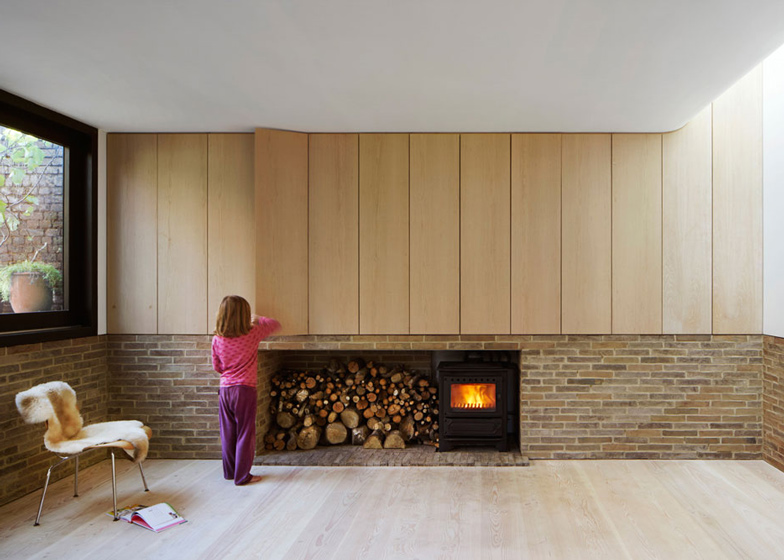Architecture studio Piercy & Company has slotted a family house behind a nineteenth-century stable facade in south-west London, creating a pair of rusted gable walls with a glazed stairwell in between (+ slideshow).
Located within a conservation zone near Kew Gardens, the three-storey Kew House was designed by London studio Piercy & Company to respect the scale and massing of its historic surroundings, but also create a generous modern home for a family.
To achieve this, the architect retained the ageing stable wall at the front of the property, then replicated its shape to create a pair of matching two-storey wings behind.
Both of these were then clad with pre-weathered steel, providing a counterpoint to the old brickwork. In some places the steel covers the windows, but is speckled with irregular perforations that allow an exchange of light and views.
"The deep orange tones of the weathering steel and the perforations within this skin echo the dappled light and autumnal palette of nearby Kew Gardens," said the architect in a statement.
A glazed stairwell connects the two wings, framing an entrance patio at the front of the property and a secluded courtyard at the rear. There's also a large basement that spans the site to unite the wings on the lowest level.
The interior layout was arranged according to how the family expected to use the space, which the architect says "ranged over imagining the children running about the house, summer dinners spilling outside and the balance of quiet nooks with social spaces, to pragmatic concerns like drying laundry and how to build a boat in the basement."
Both wings contain living rooms on the ground floor and bedroom spaces upstairs. The kitchen and family dining room is located on the northern side, with a laundry room and pantry, while a lounge sits at the southern end and is sunken below ground by a metre.
Referred to as "the snug", this room also features exposed brickwork, built-in oak-veneer cupboards and a narrow curving lightwell.
"The [rooms] are intended to be informal but rich with incidental spaces, unexpected light and complex vertical volumes," said the architect.
The large basement allowed the architects to establish an on-site joinery workshop during the build. This allowed the team to experiment with different construction techniques and put together bespoke panelling and furniture.
The space now functions as a place where one of the residents, who works as an engineer, can focus on personal projects.
Photography is by Jack Hobhouse.
Here's the project description from Piercy & Company:
Kew House
Set within the Kew Green Conservation Area of south-west London, the four bedroom family house is formed of two sculptural weathering steel volumes inserted behind a retained nineteenth century stable wall. The brief evolved through a series of conversations with clients Tim and Jo Lucas, which ranged over imagining the children running about the house, summer dinners spilling outside and the balance of quiet nooks with social spaces, to pragmatic concerns like drying laundry and how to build a boat in the basement. In response, Piercy&Company designed the house as a built diagram of the way the family wanted to use the spaces, with an internal landscape of alternative routes and levels connecting expressive spaces aimed at creating moments of delight for adults and children alike.
First and foremost a family home, the spaces are intended to be informal but rich with incidental spaces, unexpected light and complex vertical volumes. The house is formed of a simple plan to make the most of the constrained site, reduce the building’s mass in the streetscape and respond to the living patterns of the family. Consisting of two rectangles; one slightly smaller, set back and sunken 1m lower, the wings each have living spaces on the ground floor and bedrooms above. Connecting the wings is a glass encased circulation link which allows light to pour into the house whilst providing breathing space between internal spaces.
The two shells housing the main living and sleeping areas are formed of 4mm weathering steel, a hardworking combination of structure and facade. The weathering steel is maintenance free, essential for the enclosed site, and is softened by a patchwork of expressed welds and perforated panels. The deep orange tones of the weathering steel and the perforations within this skin echo the dappled light and autumnal palette of nearby Kew Gardens. Inside, oak veneer panelling and Dinesen flooring are the basis of a light, natural and refined palette of materials.
A list of planning constraints – including a conservation area context, a change of use and no access on three sides – formed a backdrop to the project. To overcome these challenges Piercy & Company inserted the house behind a retained 19th century brick gable end and split the house into twin gabled forms in keeping with local massing. The natural patina of the weathering steel with its marks, stains and perforations giving the surfaces different characters depending on the exposure and orientation, anchor the form into its context and impart a sense of permanence.
Kew House was an experimental build, driven by the architect's and client's shared interest in a kit-of-parts approach and the self-build possibilities emerging from digital fabrication. The weathering steel shells were prefabricated in Hull and then craned into place and welded together.
CNC milling and the on-site joinery workshop were used to create bespoke panelling, furniture and cabinetwork that could be fitted by the client and a small team of architecture graduates, testing the theory that digital fabrication can reduce the distance between design and production. The implications of this technology for house building are manifold with bespoke fit-out on a budget becoming increasingly viable.
Client: Tim & Jo Lucas
Architect: Piercy & Company
Structural Engineer: Tim Lucas (Price & Myers)
M&E Engineer: Arup
Sustainability Consultant: Price & Myers
Key Sub-Contractors: Commercial Systems International (CSI), Estbury Basements, Sam Lucas





